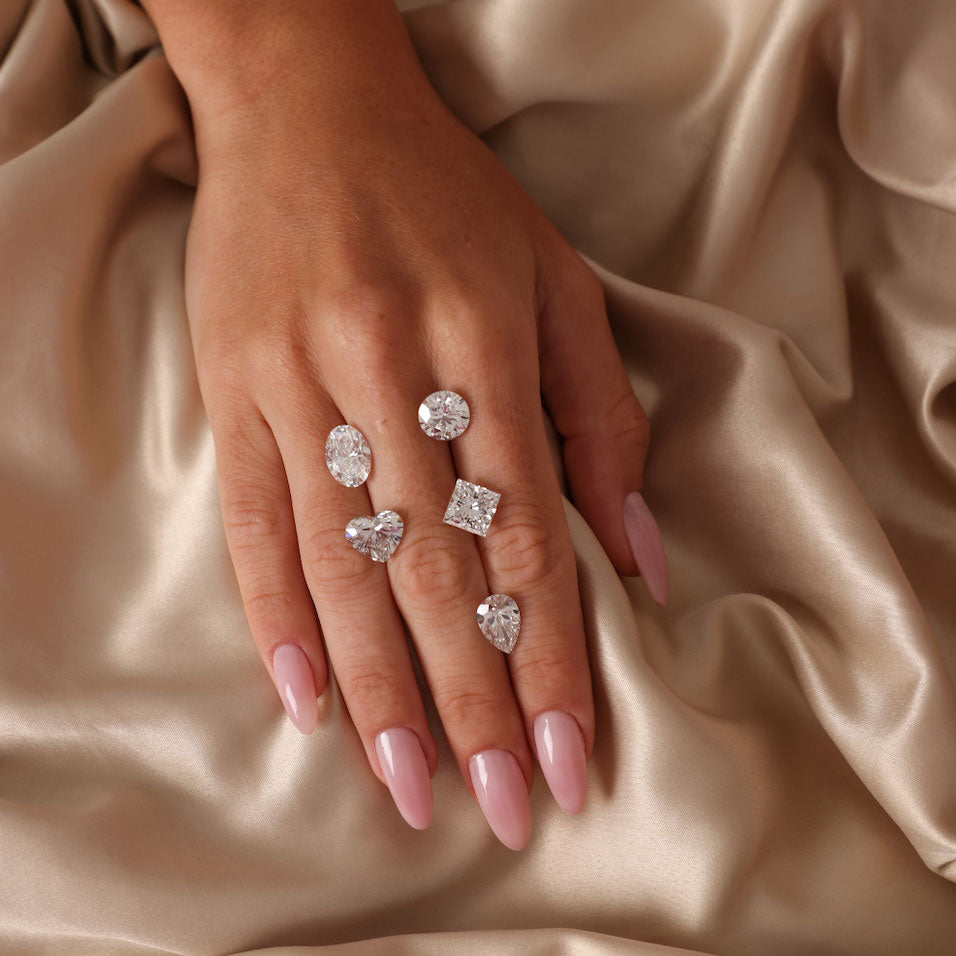Lab-Grown Diamond Guide
Lab-Grown Diamond 101
Lab-grown diamonds, also known as created, cultured or man-made diamonds, are chemically and structurally natural diamonds that have been grown in a lab setting, rather than dug up in a mine. Though identical in every way to “natural” diamonds, their cultivation requires none of the human exploitation and environmental degradation that has made mined diamonds increasingly unfavorable in recent years.
Are Lab-Grown Diamonds Real?
Lab-grown diamonds are 100% real! In most cases, the only discernible difference is the higher level of clarity and quality that lab-grown diamonds can offer over mined diamonds. Chemically, structurally, and atomically identical to mined diamonds, lab-grown stones offer all of the brilliance, beauty and longevity without any of the negative social or environmental consequences.
How Are Lab-Grown Diamonds Made?
Lab-grown diamonds are created through one of two methods: high pressure, high temperature (HPHT), which is more common, and chemical vapor deposition (CVD), which is a more specialized way of producing roughs.
The High Pressure, High Temperature Method
First developed in the 1950s, HPHT relies on a series of presses to replicate the intense heat and pressure under which natural diamonds are created. In this method, very small diamond seeds are placed in carbon in the form of metal. Next, it’s heated above 1,400 °C (2,550 °F) and pressure of about 1.5 million PSI is applied to dissolve the high purity carbon source. At this point, it's transported to the small diamond seeds and precipitates, forming a large synthetic diamond as it cools. Depending on factors like temperature, pressure, and time, the HPHT process can also be used to enhance the color of diamonds to make them colorless, pink, green, blue, or yellow. Though more common, it requires a lot of energy and resources to produce the required heat and pressure, making this process much dirtier, more carbon-heavy, and less eco-friendly than CVD.
The Chemical Vapor Deposition Method
Chemical vapor deposition is a process that involves the reaction of gas, which is injected into a vacuum chamber, breaking down into the desired coating and bonding to a material's surface.
It all starts with a thin sliver of natural diamond, which is placed within a plasma reactor. Next, various carbon-rich gasses are injected to replicate a diamond’s natural conditions. Under extreme pressure and heat, the atomized carbon disintegrates from the gasses and forms layers over the diamond seed—much in the same way that a mollusk layers minerals over a grain of sand to create a pearl.
At this point, the original natural diamond sliver can be sliced off and reused to seed more cultured diamonds. Once a grwn diamond is fully formed, it is cut and polished the traditional way—by expert craftsmen, using traditional tools to create a final one-of-a-kind stone of unmatched brilliance and perfection.
The result is a pure, certified type 2A diamond—the purest certification a diamond can be. Cleaner and more eco-friendly than HPHT, all grwn diamonds are crafted exclusively through CVD in a hydro-powered foundry.
Which Method is Better?
While methods can create a beautiful, sparkling diamond, The HPHT process is very costly, given the energy and equipment required, and produces diamonds with mainly yellowish or brownish yellow colors. The CVD method is much less costly because it works at moderate temperatures and low pressure, which requires smaller and less expensive equipment. Moreover, HPHT diamonds grow in 14 different growth directions, also known as a cuboctahedron shape. CVD diamonds, however, have a cubic shape and only one growth direction, making the roughs more uniform and better suited for more precise cutting.
Why is Lab-Grown Better than Mined?
Not all diamonds are created equal. Perhaps the main way in which lab-grown diamonds are superior to mined diamonds is just that—their superiority. Whether it’s carat, color, or clarity, CVD created diamonds offer a higher level of perfection over mined diamonds. But, in a perhaps more impactful way, when you choose grwn lab-grown diamonds, you’re opting for a cleaner, more environmentally friendly, and socially conscious diamond.
While many lab-grown diamonds are made in fossil fuel-dependent foundries, our CVD diamonds are made in a zero-emission foundry that uses renewable hydropower for a minimal carbon footprint. For every carat of grwn diamonds, 250 tons of earth and 143 lbs. of carbon dioxide are kept from degrading our environment. Simply put, lab-grown is the option for those who want a premium luxury product they can be proud to wear.
Are lab-grown diamonds certified?
Yes! Our diamonds go through a full grading process that considers the 4Cs. All grwn diamonds include written certification to ensure the origin. Never purchase a diamond without certification.

FOX5 NEWS REPORTS
Grwn Diamonds released a study on the best and worst states for marriage. The study took a look at data from the CDC and the Census Bureau to help make their final decision.
COLLABORATIONS

















